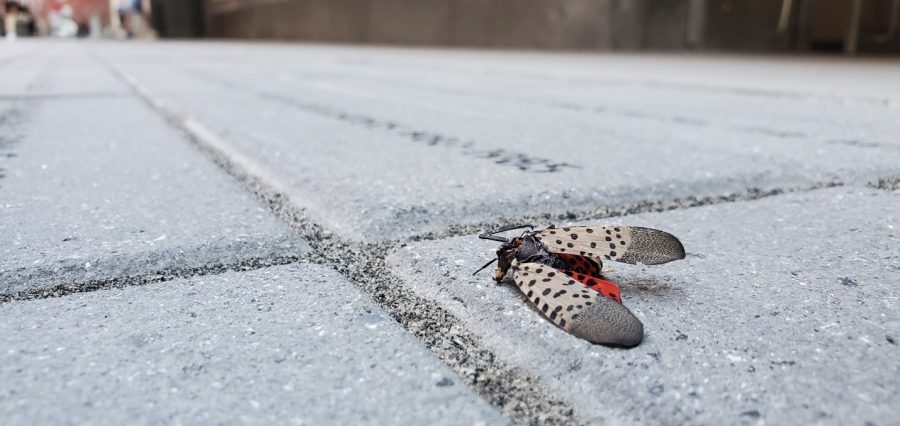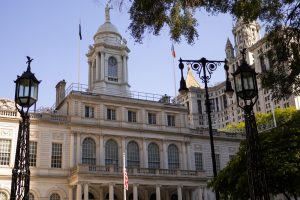Spotting the spotted: invasive spotted lanternfly comes to New York
October 28, 2021
One of New York’s most controversial new residents is beautiful, destructive and just around an inch long.
In August 2020, the first spotted lanternfly sighting in New York City was confirmed in Staten Island, marking the arrival of a new invasive species that prompted local officials to take the unusual step of urging the public to destroy them.
The spotted lanternfly is a planthopper native to China and invasive to Korea. In September 2014 the first sighting was confirmed in eastern Pennsylvania. The international flow of invasive species is not one–way, as many species native to North America are in turn invasive in other countries including the eastern bullfrog and largemouth bass.
The spotted lanternfly use their specialized mouthparts to feed on the sap of trees, which weakens them. Its sugary waste product, honeydew, can not only make these trees vulnerable to mold, but also attract a wide variety of other insects including ants, bees, hornets and paper wasps.
In its native range, the spotted lanternfly prefers to both feed and lay eggs on the toxin-producing tree of heaven. This tree is also invasive to the United States and was first introduced by European settlers in Pennsylvania in 1784 for horticultural purposes, making its history an example of how conservation efforts cannot ignorethe impacts of colonialism.
The spotted lanternfly, however, is not a picky creature. In the absence of tree of heaven it will lay its eggs on “any flat vertical surface, including other trees, stones, vehicles, outdoor furniture and many others,” according to the Maryland Department of Agriculture.
Though its adult form is striking, its eggs are easily overlooked, making them prone to being unwittingly transported through shipping. Several states, including Pennsylvania and New Jersey, have established quarantine zones where the movement of materials that may harbor the insect is regulated.
When accidentally introduced to South Korea in 2006, the spotted lanternfly became an economic pest that impacted at least 65 species. Its presence in the United States also poses a risk to fruit trees, plant nurseries and the timber industry across the eastern part of the country, and potentially wine and hops-growing in Pacific-coastal states if it moves westward.
No sightings have been confirmed in Canada, although it was preemptively placed on its regulated pest list in 2018.
Scientists are currently learning more about the spotted lanternfly’s feeding habits and one-year lifecycle to determine how to best control it. South Korean efforts include an investigation of whether the sugar content of plants affects the lanternfly’s attractivity to it.
In the United States, Pennsylvania has been in many ways a leader in research — a noncomprehensive list by the Pennsylvanian Department of Agriculture gives at least 29 in progress, completed and ongoing research projects. In June 2020, The Pennsylvania State University released PestWatch, an online modeling tool that uses weather records to help predict when eggs will hatch.
The university’s best management practices for homeowners currently include destroying spotted lanternfly eggs by crushing or dropping them into an alcohol-based solution, like rubbing alcohol or hand sanitizer, and removing tree of heaven, with the exception of trees fitted with wildlife proofed sticky or circle traps.
Only insecticides approved by the Environmental Protection Agency should be used, and homeowners should be conservative with its application since many are both toxic to humans and native wildlife. Other insecticides may require professional application. With excessive use pests may become resistant.
But research into biocontrol methods may result in more environmentally-friendly solutions than traditional insecticides.
The Pennsylvania State University and Cornell University in 2019 found Beauveria fungi — which is harmless to humans and already used in multiple EPA-approved pesticides, though it carries some potential risk to bees — to be effective against spotted lanternflies.
The United States Department of Agriculture is also investigating the potential of a lantern–fly killing wasp, Dryinus browni. With the collaboration of Chinese researchers, they brought live specimens into the country the same year.
For now, the wasps are under tight quarantine in the U.S.D.A. labs where red lighting, which the wasps cannot see, and environmental chambers make studying them easier.
Researchers wish to ensure that the wasps will not become as invasive as the pests they are meant to control, an unfortunate state of affairs that perhaps most infamously occurred with cane toads in Australia.
Dr. J. Stephen Gosnell, assistant professor in Baruch College Department of Natural Science, emphasized the importance of public diligence in reporting spotted lanternfly sightings and obeying any applicable quarantines,
He mentioned that biocontrol methods researched in relation to the emerald ash borer may be used against spotted lanternflies as well, and the invaluable nature of the peer review process facilitated by academic journals.
Although Dr. Gosnell’s work does not involve research on spotted lanternflies, he has expertise in understanding the patterns behind and in restoring ecosystem diversity, particularly in the Hudson River watershed — which harbors established communities of many different invasive species, including zebra mussels— through field, lab and big-data quantitative analysis in the Gosnell Lab.
Dr. Gosnell also advocated for improved international academic communications, particularly through translations and open-access academic journals. He added that the general public can volunteer with New York state agencies to identify spotted lanternfly and tree of heaven and stay informed on current research through Google Scholar.
Although the NYS Department of Agriculture is not currently accepting additional spotted lanternfly specimens, New Yorkers are encouraged to take photos of the lanternfly and report sightings by emailing Forest.Health@parks.nyc.gov or spottedlanternfly@dec.ny.gov and filling out a survey created by the NYS Department of Agriculture and Markets.
The fate of the spotted lanternfly is unknown, but one thing is certain: it faces considerable opposition from researchers of all kinds from around the world.









